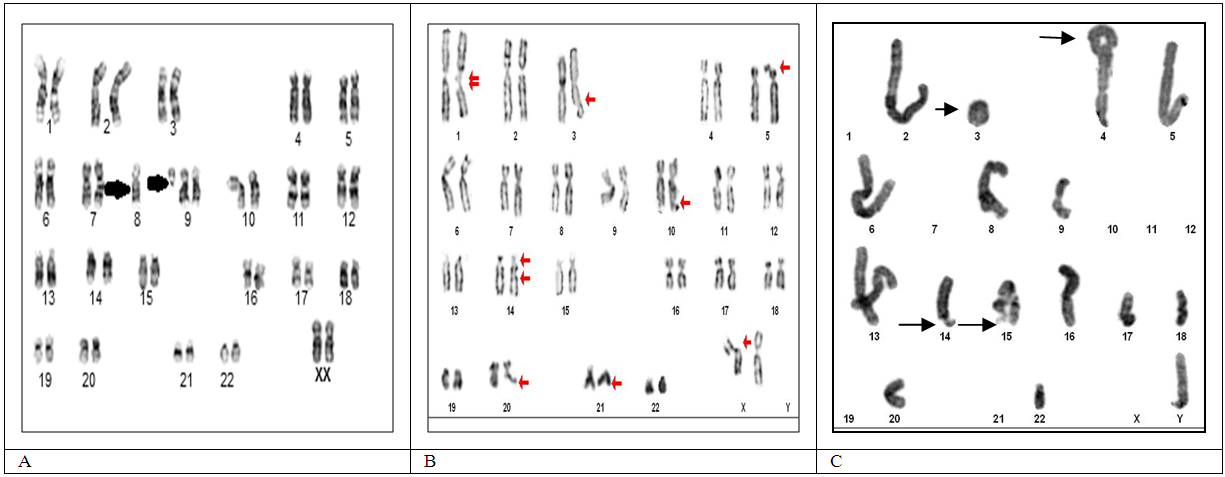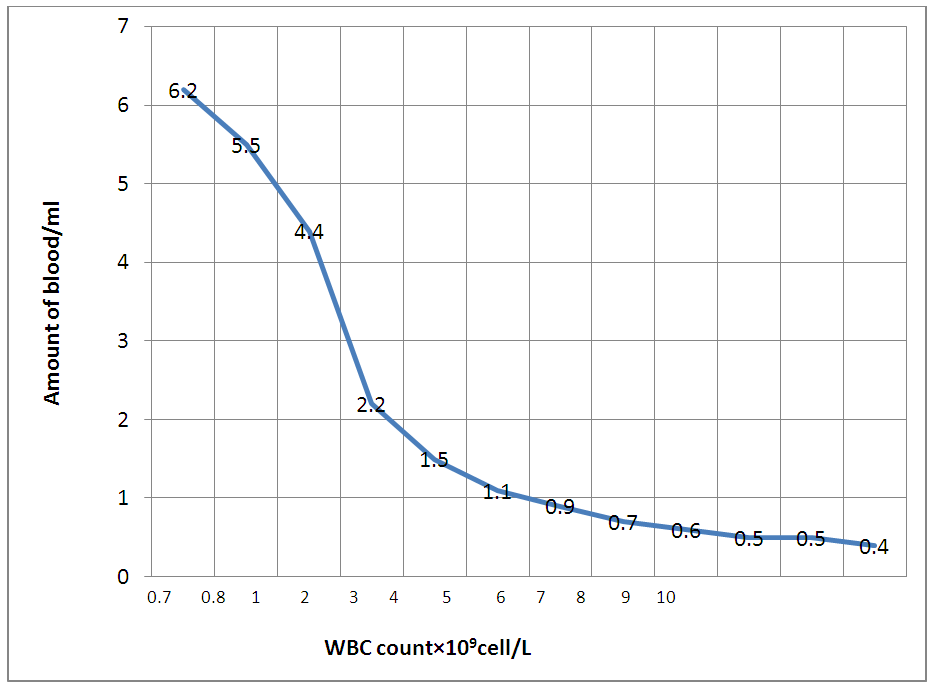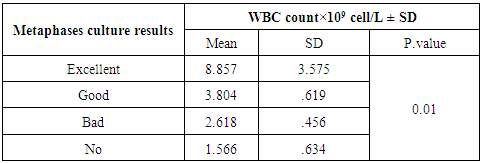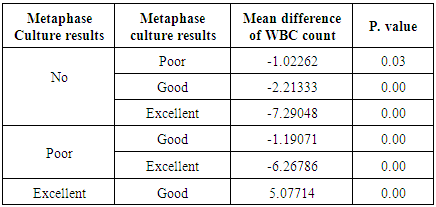-
Paper Information
- Previous Paper
- Paper Submission
-
Journal Information
- About This Journal
- Editorial Board
- Current Issue
- Archive
- Author Guidelines
- Contact Us
American Journal of Medicine and Medical Sciences
p-ISSN: 2165-901X e-ISSN: 2165-9036
2017; 7(3): 142-146
doi:10.5923/j.ajmms.20170703.06

Improvement of Outcome of Chromosomal Breakage Test Using Novel Statistical Equation
Ream Elzain Abdelgadir Mohamed1, Elshibli Mohamed Elshibli2, Abdel Rahim Mahmoud Muddathir3, Imad Mohamed Fadl-Elmula4
1Hematology Department, Faculty of Medicine and Health Science, Kordofan University, Elobied, Sudan
2Information Technologist, Al Neelain University, Sudan
3Department of Clinical Laboratory Sciences, Faculty of Applied Medical Sciences, Taibah University, Medina, Kingdom of Saudi Arabia; Department of Hematology and Blood Transfusion, Faculty of Medical Laboratory Sciences, Alzaeim Alazhari University, Khartoum, Sudan
4Department of Clinical Genetics, Al-Neelain University, Khartoum, Sudan; Elite for Health & Medical Services, Khartoum, Sudan
Correspondence to: Abdel Rahim Mahmoud Muddathir, Department of Clinical Laboratory Sciences, Faculty of Applied Medical Sciences, Taibah University, Medina, Kingdom of Saudi Arabia; Department of Hematology and Blood Transfusion, Faculty of Medical Laboratory Sciences, Alzaeim Alazhari University, Khartoum, Sudan.
| Email: |  |
Copyright © 2017 Scientific & Academic Publishing. All Rights Reserved.
This work is licensed under the Creative Commons Attribution International License (CC BY).
http://creativecommons.org/licenses/by/4.0/

Background and Purpose: This study aimed to develop a statistical equation to determine the amount of blood needed for cytogenetic culture in chromosomal breakage test, based on the white blood cell (WBC) count of the tested patients. Material and Methods: A total of 69 patients with aplastic anemia and a provisional diagnosis of Fanconi anemia were enrolled in the present study. The WBC count and chromosomal breakage test were performed for all patients. Correlation between WBC count and the successful cell cultures was determined using ANOVA test. Then the correlations between WBC count, cell culture result, and quality of metaphases were determined using Pearson's correlation test. The equation was then used to determine the needed amount of blood. Result: Of the 69 cultures, 60(87%) showed an adequate number of metaphase, of which, 8 had excellent metaphase appearance, 25 had good appearance and 27 had a bad appearance. The remaining 9(13%) failed to grow in culture. ANOVA test showed that cell culture success was correlated positively with WBC count (P.value = 0.01), furthermore, Pearson's correlation showed the cell culture result and metaphase quality was correlated positively with WBC count (P.value = 0.00). The equation was established statistically. Conclusion: The equation obtained by the study may improve the success and quality of chromosomal breakage test. However, future study needs to validate the value of the equation.
Keywords: Cytogenetic, Chromosomal, Fanconi anemia
Cite this paper: Ream Elzain Abdelgadir Mohamed, Elshibli Mohamed Elshibli, Abdel Rahim Mahmoud Muddathir, Imad Mohamed Fadl-Elmula, Improvement of Outcome of Chromosomal Breakage Test Using Novel Statistical Equation, American Journal of Medicine and Medical Sciences, Vol. 7 No. 3, 2017, pp. 142-146. doi: 10.5923/j.ajmms.20170703.06.
Article Outline
1. Introduction
- Fanconi anemia (FA) is a rare disorder which exhibits an autosomal recessive inheritance disease, except for FA-B, which has an X-linked mode of inheritance [1]. The disease is characterized by diverse clinical symptoms including developmental defects, bone marrow failure and high risk of malignancies. As the clinical presentations are highly variable, the diagnosis of FA on the basis of clinical features is virtually impossible [2]. Chromosomal breakage test is used widely in the diagnosis of FA [3]. The test involves detection of chromosomal breakage and/or aberrations which include chromatid gap and breaks, triradial, quadriradial and chromosomal rearrangements after adding DNA clastogenic agents, such as diepoxybutane (DEB) or mitomycin C (MMC) to lymphocyte culture of the patient [4]. Although the chromosomal breakage test has been considered as a gold standard method for diagnosing of FA, the test may be affected by many factors that can hamper its success[5]. Reduced mitotic index due to pancytopenia associated with FA cases remains the initial failure factor [6]. As the determination of the blood amount used in cytogenetic cell culture is important to obtain enough and excellent metaphases [7], this implies that an increase of peripheral blood (lymphocyte density) may increase the chance for a success rate of chromosomal breakage test. The present study aimed to determine the amount of peripheral blood required for chromosomal breakage test with reference to the total leukocyte count for a successful outcome in terms of adequate number and good quality metaphase using statistical equation.
2. Materials and Methods
- The study included 69 patients with aplastic anemia and a provisional diagnosis of FA (FA patients show positive chromosomal breakage test, patients have negative chromosomal breakage test regards as acquired aplastic anemia) [3]. All patients referred to Elite clinic, Khartoum, Sudan for chromosomal breakage test during February 2011 and September 2013. The Ethical Committee of Ministry of Health, Khartoum -Sudan approved the study, and written informed consent from all Patients' parents was obtained, before sample collection. Demographic and clinical data have been recorded from each patient before collecting 5 ml of venous blood which used for WBC count using automated hematology analyzer SYSMEX KX-21N®, and chromosomal breakage test using mitomycin-C (MMC) as DNA cross- linking agent according to conventional protocol. In brief, a total of 0.5 ml of heparinized peripheral blood was added to 10 ml of RPMI 1640 media in sterile 15-ml blood- culture flask. The media was supplemented with 3.4% phytohemagglutinin, 25% fetal bovine serum, 1% penicillin-streptomycin, and 80 µl of MMC. All cultures incubated at 37°C and harvested 3 days later after adding 100 µl of colcemid to arrest cells in metaphase. After the hypotonic shock in 0.075 M potassium chloride, the cells were fixed three times in methanol: acetic acid (3:1). G-banding was obtained with Wright’s stain [8]. The quality of each culture has been assessed for the number of metaphases and chromosomal band resolution. Those metaphases with 600 bands resolution were considered excellent, metaphases with 403 bands resolution were considered good, and those with 350 and/or fewer bands resolution were classified as poor metaphases [9] (Fig1).
 | Figure 1. Metaphase quality classification according to the band resolution, A) Excellent, B) Good and C) Bad |
3. Statistical Analysis
- Data were analyzed using SPSS version 21. A t-test was used to determine the correlation between the WBC count and the cell culture success. Correlations between the WBC count and different groups of the cell culture result were determined using ANOVA test. Correlations between WBC count, and both, the cell culture result and the quality of the cultures were determined using Pearson's correlation test. P-value of 0.05 and below was considered of significance. The statistical equation was adjusted to determine the amount of blood to be taken from each patient to obtain excellent metaphase assuming that the WBC count would affect the cell culture result and the quality of cell culture, in which the quality and success of the cell culture improved when the WBC counts increased and vice versa.
4. Results
- Of the 69 patients with aplastic anemia referred to Elite clinic for chromosomal breakage test, 60/69 (87%) showed an adequate number of metaphase for chromosomal breakage analysis. The remaining 9/69 (13%) cases showed a complete failure of culture growth. The results revealed that 8/60 (13.3%) cases had excellent metaphase quality, 25/60 (41.7%) cases had good metaphase quality, and 27/60 (45%) cases showed poor metaphase quality. Chi- square test showed significant statistical differences (P. Value < 0.00) for the different groups of cultures.Statistical analysis showed WBC count mean of 1.57×109/L ± 0.63 SD for cases with no culture result, and WBC count mean of 3.82×109/L ± 2.3 SD for cases with successful culture result. Independent T-test showed that the mean of WBC count and the chromosomal breakage test culture result was positively significant (P.value = 0.005).ANOVA test showed significant statistical differences (P. Value = 0. 01) for the WBC count means and the different groups of chromosomal breakage test culture results (Excellent result, good result, poor result and no result) (Table 1).
|
 | Figure 2. Relationship between WBC count and Metaphase groups result |
|
 0.5= amount of blood which taken in excellent metaphase.From the above equation, the amount of blood for successful lymphocyte cell culture in patients suspected with Fanconi anemia and according to the mean of white blood cell count in the excellent metaphase appearance can be calculated as showed in (Fig 3).
0.5= amount of blood which taken in excellent metaphase.From the above equation, the amount of blood for successful lymphocyte cell culture in patients suspected with Fanconi anemia and according to the mean of white blood cell count in the excellent metaphase appearance can be calculated as showed in (Fig 3). | Figure 3. Amount of blood according to the total WBC count using the novel equation |
5. Discussion
- Breakage test proved to be critical for the diagnosis and treatment of FA [10]. However, chromosomal breakage test is also known to be of limited value since the test is influenced by several factors that affect the success and the quality of the test. The present study examines the effect of WBC count on chromosomal breakage test and designs an equation to determine the amount of blood needed for a successful culture based on WBC count. Certainly, this is going to improve the outcome of chromosomal breakage test and reduce the culture failure.In the present study, we managed to obtain an adequate number of metaphase for chromosomal breakage analysis in 87% of the cases, 13% of the cases were a primary failure of the cultures and all these cases were found to have low WBC count. Our results are in agreement with previous studies in which 24 cases (5%) failed in cytogenetic culture due to a low number of WBC count [11]. Although several studies have suggested an association between culture failure and karyotype abnormality [12, 13], no previous studies studied the correlation between WBC count and the amount of blood used in culture. The direct novel outcome of the present study was the design of statistical equation that correlate between the WBC count and the amount of blood used in lymphocyte cell culture, so as, to obtain a successful result. The equation will certainly improve the outcome of chromosomal breakage test, reduce the cell culture failure and allow early diagnosis and management of these patients thereby reducing the complications of the disease.In fact, most of the FA patients are children between 5-7 years and if not diagnosed early they may develop acute leukemia by the age of 11-year [14]. So, the early diagnosis is crucial since bone marrow transplant remain a good therapeutic option.Another important fact supporting the needs for improvement of breakage test is the molecular characteristics of Fanconi anemia. The heterogeneity of the genetic profile implies the breakage test as the only option, especially, in a limited laboratory set up countries where sequencing is not available.
6. Conclusions
- The present study showed a strong relation between the WBC count, the amount of blood culture, and the success and quality of breakage test. Although the present study designed statistical equation that correlated between the WBC count, and the amount of blood to be cultured for the success of chromosomal breakage test, the equation may need further validation studies in future.
ACKNOWLEDGMENTS
- We acknowledge the staff at the department of pediatrics hematology at Gaffer Ibnaof hospital for children and Elite clinic center for their help.
 Abstract
Abstract Reference
Reference Full-Text PDF
Full-Text PDF Full-text HTML
Full-text HTML
